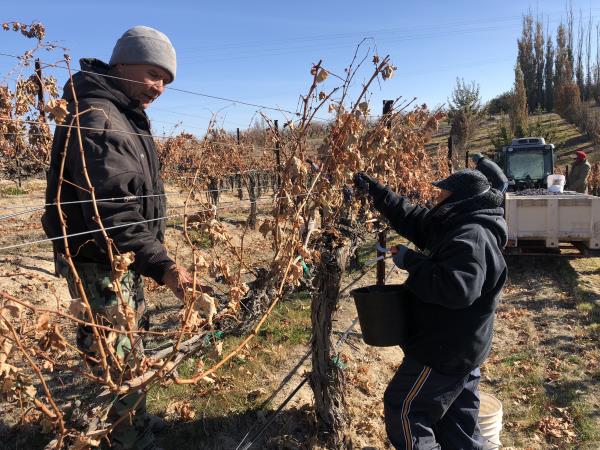Idaho wine's economic impact on state hits $210 million

POCATELLO – The impact that Idaho’s wine industry has on the state’s economy has grown substantially in recent years.
According to a recently completed economic impact study, Idaho’s grape growing and wine making industry had a $210 million economic impact on the state in 2017.
That’s up from the $169 million impact the industry had in 2013, according to the last such wine impact study. In 2007, a Boise State University study found the state’s wine industry had a $73 million impact on Idaho’s economy.
The results of the latest study “shows that we have had continued growth in the wine industry and that the industry is an important economic driver for the state of Idaho,” said Idaho Wine Commission Executive Director Moya Shatz-Dolsby.
“The wine industry is becoming an influential agricultural commodity in Idaho,” she said. “When you see that ($210 million) number, it kind of speaks volumes.”
That total includes industry operations, downstream distribution and sales and associated wine tourism activities.
The recent study was commissioned by the IWC and funded through specialty crop grant money provided to the commission by the Idaho State Department of Agriculture.
It was conducted by Community Attributes Inc., which is based in Seattle and pulled information from a variety of sources, including the U.S. Census Bureau, Alcohol and Tobacco Tax Trade Bureau and the Idaho State Tax Commission. Stakeholder surveys and interviews also contributed to the study.
When the 2013 study was conducted, there were 50 wineries in the state. There are 60 now. There were fewer than 10 wineries in Idaho around the year 2000.
According to the study, total wine sales within the state nearly doubled from 2011 to 2017. Idaho wine sales within the state increased by 51 percent from 2013 to 2017 and currently, 10 percent of all wine sold within the state is Idaho wine.
“Results reveal tremendous growth and clearly indicate significant opportunities for the future,” an IWC news release said about the study, which can be viewed at the commission’s website at idahowines.org.
The study found that one of the Idaho wine industry’s biggest strengths is that Idaho wines “are price competitive and a great value. Idaho produces premium wines at a price point often below those available from Washington state, California and Oregon.”
This is due to the lower cost of wine grapes produced in Idaho, even for high-quality gapes. According to the people interviewed for the study, a ton of red wine grapes produced in Idaho sells for $1,600 on average and white wine grapes sell for $1,400 per ton on average.
That compares to $2,400 and $2,200 per ton in Washington.
Another bright spot for the state’s wine industry is that Idaho has been the fastest growing state in the nation recently on a percentage basis.
“Idaho is growing in population and this growth supports wine consumption,” the study states.
While the study showed there are tremendous growth opportunities for Idaho’s wine industry, it also listed come challenges to growth, including limitations in in-state grape production and the availability of key infrastructure.
Brand awareness was another key challenge.
“According to interviewees, reputation and brand awareness remain two of the largest constraints on growth,” the study states. “Idaho has yet to develop a national reputation for high-quality wines as has been established by Washington, Oregon and California wineries, which creates downward pressure on prices.”
According to the study, Idaho wines are relatively rare in stores and restaurants outside of the state.
But it also adds, “Though still uncommon, Idaho’s brand as a quality winemaker is growing. Food & Wine Magazine called it ‘the next must-go-see-taste wine destination in the country,” while Wine Enthusiast says the region has ‘endless potential.’”
The study also pointed out that while it’s growing quickly, Idaho’s wine industry is still tiny compared to other Western U.S. wine growing regions in California, Washington and Oregon.
For example, while Idaho harvests an average of 3,000 tons of wine grapes and produces almost 200,000 cases of wine per year, Washington produced 229,000 tons of grapes and about 13 million cases of wine in 2017.
However, the study states, “Despite its small size, Idaho is steadily gaining a reputation as a producer of award-winning wines and as a destination for wine tourism.”
Still can't find what you are looking for? Find by topic:
- Achievement Award (YF&R)
- Actions Alerts
- Advocacy
- Ag Ambassadors
- American Farm Bureau
- American Farm Bureau Policy Book
- Archive Photos
- Articles
- Board of Directors
- Calendar - State/District
- Calendar - County
- Capitol Reflections
- Collegiate Chapters
- Committee Application Form
- Commodities
- Convention Annual
- County Presidents & Board Information
- County Resource Page
- Delegate Form
- Discount Programs
- Discussion Meet
- Discussion Meet - High School
- Education Programs
- Events
- Excellence Award (YF&R)
- Expense Voucher
- Flickr
- Gem State Producer
- High School Discussion Meet
- High School Speech Contest
- Hope in Idaho Ag
- House of Delegates Credentials Form
- IFBF Board of Directors
- IFBF Policy Book
- IFBF Staff
- Insurance
- Legislative Action Program
- Legislative Issues
- Library
- MAC Trailer
- Magazines
- Map My Benefits
- Member Benefits
- Member Discount
- Membership Application
- Mission Statement
- Moving Agriculture to the Classroom
- Newsletter Sign up
- News Releases
- News Room
- Open Range Law
